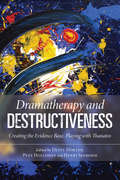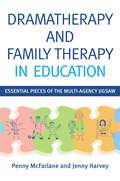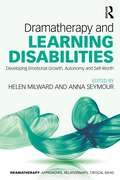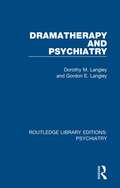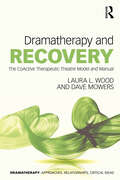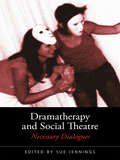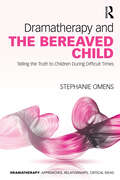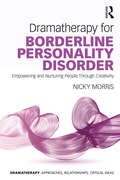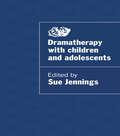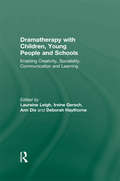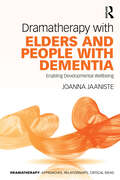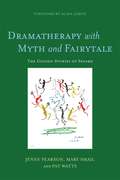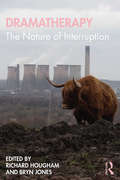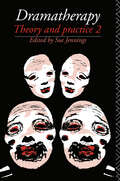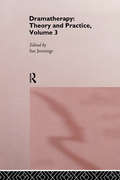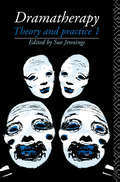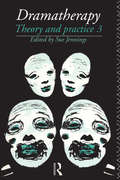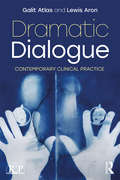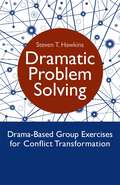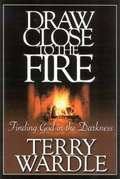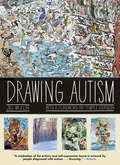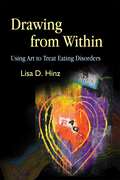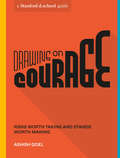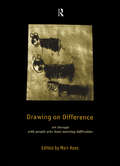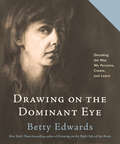- Table View
- List View
Dramatherapy and Destructiveness: Creating the Evidence Base, Playing with Thanatos
by Ditty Dokter Pete Holloway Henri SeebohmDramatherapy uses the healing aspects of drama and theatre as part of the therapeutic process and is increasingly required to supply evidence of its effectiveness. This book aims to provide an evidence base for practice with destructive clients, and raise the profile of dramatherapy as a distinct therapeutic intervention in this field. Dramatherapy and Destructiveness discusses working with those suffering from conduct disorders, mood disorders, schizophrenia and personality disorders. Divided into three parts, topics of discussion include: theory and research underpinning the understanding of working with destructiveness in-depth case studies of dramatherapy with a wide range of clients analysis and evaluation of the evidence base for dramatherapy with these clients guidelines for best practice Dramatherapy and Destructiveness covers a wide range of client groups, settings, methods and therapeutic approaches. As well as being an invaluable resource for dramatherapists, this book will be of interest to other therapists, health professionals, social workers, teachers and artists.
Dramatherapy and Family Therapy in Education
by Penny Mcfarlane Jenny HarveyA collaborative therapeutic approach often proves the best way to assess and meet the needs of children experiencing barriers to learning. This book gives a concise overview of drama and family therapy and describes how both therapies can work together to provide essential pieces of the jigsaw of emotional support for troubled children within an educational setting. Drawing on their own extensive experience, the authors give explanations of the models and techniques of their own specialist therapy, before exploring their joint work and innovative inclusion in a cooperative team of multi-disciplinary professionals. The book discusses the principles and protocols of a Multi Agency Support Team and looks at how the pieces come together in practice. Case studies are provided to illustrate the successful outcomes of this way of working, as well as the challenges it can present. This book will be vital reading for all professionals working alongside children, families and schools, who are interested in addressing the needs of the child on a deeper and more sustainable level.
Dramatherapy and Learning Disabilities: Developing Emotional Growth, Autonomy and Self-Worth (Dramatherapy)
by Helen MilwardDramatherapy and Learning Disabilities demonstrates the power of dramatherapy to help clients with learning disabilities, addressing current research, evidencebased work, and methods in the dramatherapy and learning disabilities fields. Featuring contribution from 19 dramatherapists with a range of clients of all ages who have moderate to severe learning disabilities, this book presents ways in which dramatherapists are innovating new approaches to their work in the field. The authors demonstrate their expertise but also acknowledge their limitations. They explore what it is like to work in multidisciplinary teams and with parents and carers of children and adults with learning disabilities. Each chapter provides detailed vignettes of client/therapist experience and enables the reader to gain insight into therapists’ thinking and the process that guides their clinical judgement. Structured accounts of sessions and outcomes, tracking clients’ progress and the use of evaluation tools evidence the effectivity of dramatherapy and creative therapies’ practice. This book will be a significant resource for trainee dramatherapists, arts therapists and professionals interested in incorporating creative methods into their practice. It also provides examples of burgeoning arts therapies research within the field and lays the foundations for future projects.
Dramatherapy and Psychiatry (Routledge Library Editions: Psychiatry #14)
by Dorothy M. Langley Gordon E. LangleyAs part of the overall growing interest in the rehabilitation of people with mental illness in the 1980s, therapy through drama was being seen increasingly as a significant aspect of therapeutic programmes. While the subject of remedial drama for people with disabilities was reasonably well documented, originally published in 1983, this was the first book to address the topic applied to psychiatric patients (or clients). The book is intended to be practical throughout and keeps jargon to a minimum. It is not written for professional or student dramatherapists alone, but is aimed as much at occupational therapists, nurses, social workers, psychiatrists and psychologists who are all involved in rehabilitation of people with mental illness. Topics discussed include referral by the psychiatrist, and general and specific approaches to dramatherapy. In addition, practical application is given to particular groups such as elderly people and those with schizophrenia.
Dramatherapy and Recovery: The CoActive Therapeutic Theatre Model and Manual (ISSN)
by Laura L. Wood Dave MowersDramatherapy and Recovery offers a comprehensive and groundbreaking approach to harnessing the power of theater in the recovery process through the use of playmaking and performance.This manual is based on the CoActive Therapeutic Theater (CoATT) model, the first of its kind to be meticulously documented and standardized. With its emphasis on replicability and measurable outcomes, the CoATT model is brought to life through annotated scripts and progress notes extracted from past productions involving diverse populations, including those with eating disorders, aphasia, schizophrenia, and substance abuse disorder. The authors illuminate the six principles that distinguish CoATT from other therapeutic and applied theater approaches. The chapters provide a structured framework compromising seven defined movements that act as attainable milestones for participants guided towards producing a powerful and transformative public performance.Dramatherapy and Recovery equips practitioners of dramatherapy, counseling arts in health, applied theater, community theater, and other mental health disciplines with the tools needed to create transformative performances with individuals reconnecting with the community after treatment.
Dramatherapy and Social Theatre: Necessary Dialogues
by Sue JenningsDramatherapy and Social Theatre: Necessary Dialogues considers the nature of drama, theatre and dramatherapy, examining how dramatherapy has evolved over the past decade and how the relationship between dramatherapy and social theatre has developed as a result. In this book Sue Jennings brings together international dramatherapists and theatre practitioners to challenge, clarify, describe and debate some of the theoretical and practical issues in dramatherapy and social theatre. Contributors cover topics including: dramatherapy in communities ground rules and definitions cross-cultural perspectives dramatherapy with adoptive and foster families research with professional actors. Dramatherapy and Social Theatre is illustrated throughout with case vignettes providing examples of how theatre and therapeutic processes can be brought together. It will be valuable reading for both professionals and students involved in dramatherapy and theatre studies.
Dramatherapy and the Bereaved Child: Telling the Truth to Children During Difficult Times (ISSN)
by Stephanie OmensThis book addresses the needs of children experiencing the hospitalization or death of a caregiver or loved one to comprehend and cope with tragedy with the assistance creative non-fictions and dramatic play.Based on the author’s two-decade-long clinical practice and an extensive career working with bereaved children and their families as a dramatherapist and child life practitioner, this book demonstrates how storytelling and dramatherapy can be used to tell the truth to children in these difficult circumstances. Through vivid and candid case examples, the author demonstrates the developmentally normative, dramatic, and psychotherapeutic principles that inform her work. She shares stories for children that are carefully constructed to help children understand the truth of what they are facing rather than shielding them from reality. Attuned to the children’s direct experience, these stories take care to respect the culture and context of the death, and the histories of the people involved.The book, accessibly written, will provide guidance, insight, and comfort for professionals, clinicians, and grieving children and their families. Additional reader resources can be found at https://nowhitelies.com/store and www.routledge.com/9780367461041 under "Support Material".
Dramatherapy for Borderline Personality Disorder: Empowering and Nurturing people through Creativity (Dramatherapy)
by Nicky MorrisDramatherapy for Borderline Personality Disorder: Empowering and Nurturing People Through Creativity demonstrates how dramatherapy can empower those individuals struggling to live with borderline personality disorder, and help them embrace and control the emotional inner chaos they experience. Based on current research into the aetiology, symptoms and co-morbid disorders associated with BPD (and emotionally unstable personality disorder), this book demonstrates the effectiveness of dramatherapy for individuals and groups on specialist personality disorder wards and in mixed diagnosis rehabilitation units. It also reveals a creative approach for making dramatherapy work in harmony with approaches such as dialectical behaviour therapy and cognitive behaviour therapy. Aimed at those working with service users, and utilising a range of case studies and clinical vignettes, Dramatherapy for Borderline Personality Disorder provides an insight into the potential of dramatherapy, which will be welcomed by mental health professionals.
Dramatherapy with Children and Adolescents
by Sue JenningsDrama plays a crucial role in healthy human development and dramatherapy can be particularly effective in helping troubled children or adolescents. In this book, twelve contributors, writing from a range of international and theoretical perspectives, show how the dramatic element in people's lives plays its part in patterns of healthy and unhealthy development. They describe practical ways of using dramatherapy with both groups and individuals and demonstrate that dramatherapy is a strategy that works, helping to bring about change and creativity. Dramatherapy with Children and Adolescents will be invaluable to all professionals who work with children, including social workers, probation officers, nurses and teachers, as well as dramatherapists and play therapists.
Dramatherapy with Children, Young People and Schools: Enabling Creativity, Sociability, Communication and Learning
by Deborah Haythorne Lauraine Leigh Irvine Gersch Ann DixDramatherapy with Children, Young People and Schools is the first book to specifically evaluate the unique value of dramatherapy in the educational environment. A variety of highly experienced dramatherapists, educational psychologists and childhood experts discuss the benefits to the children and young people, and also in relation to the involvement of teachers, the multi-disciplinary team and families. This professional book offers a panoramic view to explain how through dramatherapy children and young people develop their communication skills, sociability and their actual desire to learn. Detailed case studies demonstrate individual successes in youngsters experiencing a range of emotional difficulties and psychological needs. These studies include: conquering a fear of maths; violent behaviour transformed into educational achievement; safe expression of feelings for a sexually abused child; and where children are diagnosed with mental health disorders such as ADHD and ODD, where the benefits of dramatherapy with children and families are carefully described and evaluated, suggesting that this therapeutic discipline can achieve positive outcomes. The practical advice and inspirational results included here promote a future direction of integration and collaboration of school staff, multi-disciplinary teams and families. Education and equality are high on the agenda, and the function of dramatherapy is not just as a treatment, but as an economically viable and valuable preventive therapy.
Dramatherapy with Elders and People with Dementia: Enabling Developmental Wellbeing (Dramatherapy)
by Joanna JaanisteDramatherapy with Elders and People with Dementia illuminates how targeted sessions of dramatherapy can improve the quality of life of elderly people with dementia. The book takes the reader through the dramatherapy experience of a group of people who display a ‘feeling intelligence’; a quality that softens distress at vanishing words and clouded memories. Unique in its approach, not only to dramatherapy with elders and people with dementia, it presents an essential validation of older people’s life stage development. Rather than being different or ‘other’, Jaaniste paints word pictures to show human qualities such people have in common with their dementia-free contemporaries. Readers will glean insights into the arts therapies, especially creative drama, meeting examples of elder wisdom, wit and resilience in dealing with life, but especially grief, loss, and deep questions that come with ageing. Enriched with vignettes and anecdotes based on rigorous research and measurement, the book will be suitable for adaptation by arts therapists and other allied health professionals who are interested in using person-centred, strengths-based approaches.
Dramatherapy with Myth and Fairytale
by Jenny Pearson Mary Smail Pat WattsMyths and fairytales are our rich heritage; a veritable feast of ancient wisdom passed down through the ages in the memorable form of stories. While almost any story will have deep meaning to some individuals, some of the time, this book presents a collection of stories that these maestros of dramatherapy have found to have a powerful effect almost without fail. These are the 'golden' stories of Sesame. The authors introduce the Sesame approach and describe the advantages of using myth and fairy tale as a central theme in a therapy session. The Sesame approach has been found to produce striking results with myriad client groups, including individuals with learning difficulties, offenders in psychiatric settings and children with emotional and behavioural difficulties and adults in mental health care. Dramatherapy with Myth and Fairytale provides a treasure trove of timeless stories that can be adapted and applied to the needs of different client groups and the style of each therapist. It also includes introductory exercises, warm-ups and scene setting suggestions. The book will be an invaluable source of inspiration for dramatherapists and dramatherapy students, creative arts therapists, storytellers, psychotherapists, Jungian psychoanalysts, teachers and play therapists.
Dramatherapy: The Nature of Interruption
by Richard HoughamThis book investigates the nature and phenomena of interruption in ways that have relevance for contemporary dramatherapy practice. It is a timely contribution amidst an ‘age of interruption’ and examines how dramatherapists might respond with agency and discernment in personal, professional and cultural contexts. The writing gathers fresh ideas on how to conceptualise and utilise interruptions artistically, socially and politically. Individual chapters destabilise traditional conceptions of verbal and behavioural models of psychotherapy and offer a new vision based in the arts and philosophy. There are examples of interruption in practice contexts, augmented by extracts from case studies and clinical vignettes. The book is not a sequential narrative – rather a bricolage of ideas, which create intersections between aesthetics, language and the imagination. New and international voices in dramatherapy emerge to generate a radical immanence; from Greek shadow puppetry to the Japanese horticultural practice of Shakkei; from the appearance of ‘ghosts’ in the consulting room to images in the third space of the therapeutic encounter, interruptions are reckoned with as relevant and generative. This book will be of interest to students, arts therapists, scholars and practitioners, who are concerned with the nature of interruption and how dramatherapy can offer a means of active engagement.
Dramatherapy: Theory And Practice, Volume 3
by Sue JenningsDramatherapy: Theory and Practice 2 provides both clinician and theatre artist with a basic overview of recent developments in dramatherapy. The international contributors, all practising dramatherapists or psychotherapists, offer a wide variety of perspectives from contrasting theoretical backgrounds, showing how it is possible to integrate a dramatherapeutic approach into many different ways of working towards mental health.
Dramatherapy: Theory And Practice, Volume 3
by Sue JenningsThe third volume of Dramatherapy: Theory and Practice brings the reader up-to-date with the latest developments in the profession of dramatherapy and tackles key issues in contemporary social relationships. It shows how dramatherapy is evolving its own theory and methodology as well as specific models for supervision and assessment. Dramatherapy is now being used in a broad continuum of care and contributors give many examples of its practice in contexts of prevention, maintenance and cure. This new volume has twenty-nine international contributors and covers major new themes of gender, race and politics as well as incorporating the latest method, theoretical concepts and research.
Dramatherapy: Theory and Practice 1
by Sue JenningsDramatherapy: Theory and Practice 1 introduces the reader to the basic issues of dramatherapy and offers a highly authoritative guide to the clinical practitioner or teacher who wishes to use role-play and enactment in the context of therapeutic work. With its companion volume Dramatherapy: Theory and Practice 2, it provides an invaluable resource for all those whose work can benefit from the use of dramatherapy including counsellors, nurses and occupational therapists.
Dramatherapy: Theory and Practice, Volume 3
by Sue JenningsThe third volume of Dramatherapy: Theory and Practice brings the reader up-to-date with the latest developments in the profession of dramatherapy and tackles key issues in contemporary social relationships. It shows how dramatherapy is evolving its own theory and methodology as well as specific models for supervision and assessment. Dramatherapy is now being used in a broad continuum of care and contributors give many examples of its practice in contexts of prevention, maintenance and cure. * Incorporates method, theoretical concepts and latest research * Covers major new themes of gender, race and politics * 29 international contributors
Dramatic Dialogue: Contemporary Clinical Practice (Relational Perspectives Book Series)
by Galit Atlas Lewis AronIn Dramatic Dialogue, Atlas and Aron develop the metaphors of drama and theatre to introduce a new way of thinking about therapeutic action and therapeutic traction. This model invites the patient’s many self-states and the numerous versions of the therapist’s self onto the analytic stage to dream a mutual dream and live together the past and the future, as they appear in the present moment. The book brings together the relational emphasis on multiple self-states and enactment with the Bionian conceptions of reverie and dreaming-up the patient. The term Dramatic Dialogue originated in Ferenczi’s clinical innovations and refers to the patient and therapist dramatizing and dreaming-up the full range of their multiple selves. Along with Atlas and Aron, readers will become immersed in a Dramatic Dialogue, which the authors elaborate and enact, using the contemporary language of multiple self-states, waking dreaming, dissociation, generative enactment, and the prospective function. The book provides a rich description of contemporary clinical practice, illustrated with numerous clinical tales and detailed examination of clinical moments. Inspired by Bion’s concept of "becoming-at-one" and "at-one-ment," the authors call for a return of the soul or spirit to psychoanalysis and the generative use of the analyst’s subjectivity, including a passionate use of mind, body and soul in the pursuit of psychoanalytic truth. Dramatic Dialogue will be of great interest to all psychoanalysts and psychotherapists.
Dramatic Problem Solving: Drama-Based Group Exercises for Conflict Transformation
by Steven HawkinsEngaging groups in drama is a highly effective way to break down barriers and build resilient teams. This concise book of drama-based exercises will be an invaluable tool for practitioners looking to facilitate conflict transformation and is applicable to a wide range of contexts and client groups. The dramatic problem solving approach is a sequential process, from welcoming exercises and forming agreements, to analysing the root problems and building on trust, culminating in the creation of a piece of drama. Each stage is accompanied by activities and illustrated with examples from the author's extensive experience. This book will be an innovative resource for any professionals involved in groupwork including youthworkers, teachers, social workers, arts and family therapists, group psychotherapists, psychologists, school counsellors and community leaders.
Draw Close to the Fire: Finding God in the Darkness
by Terry WardleFor those experiencing the darkness of deep emotional wounds, this book lays out the source of healing and charts the path toward healthy relationships and spiritual maturity. Out of his own experiences of darkness and healing, Terry Wardle provides wise and seasoned biblical guidance for all who feel trapped in the darkness.
Drawing Autism
by Jill MullinThis &“jaw-droppingly beautiful book&” explores the work and creative process of artists diagnosed with ASD, with a foreword by Temple Grandin (Library Journal). In this volume, behavior analyst and educator Jill Mullin has assembled a staggering array of work from established artists with autism like Gregory Blackstock and Jessica Park—as well as many who are unknown but no less talented. Their creations, coupled with artist interviews, comprise a fascinating and compelling book that serves to educate and inspire anyone who knows someone diagnosed with ASD. Mullin&’s introduction and the foreword by bestselling author Temple Grandin also provide an overview of autism, and advocate for nurturing the talents, artistic and otherwise, of autistic individuals. &“What is the actual experience of living with autism in a deep-felt sense, beyond the social stereotypes and headline-worthy superskills? Drawing Autism, a celebration of the artistry and self-expression found in artwork by people diagnosed with autism, explores just that. The stunning volume features works by more than fifty international contributors, from children to established artists, that illustrate the rich multiplicity of the condition.&” —The Atlantic &“Mullin . . . brings together fascinating works by 40 artists on the spectrum with their answers to her questions about their process.&” —The Boston Globe &“A testament to the power of art to reveal the inner world of people living with ASD.&” —Publishers Weekly
Drawing from Within: Using Art to Treat Eating Disorders
by Lisa HinzDrawing from Within is an introductory guide for those wanting to explore the use of art with clients with eating disorders. Art therapy is a particularly effective therapeutic intervention for this group, as it allows them to express uncomfortable thoughts and feelings through artistic media rather than having to explain them verbally. Lisa D. Hinz outlines the areas around which the therapist can design effective treatment programmes, covering family influences, body image, self-acceptance, problem solving and spirituality. Each area is discussed in a separate chapter and is accompanied by suggestions for exercises, with advice on materials to use and how to implement them. Case examples show how a therapy programme can be tailored to the individual client and photographs of client artwork illustrate the text throughout. Practical and accessible to practitioners at all levels of experience, this book gives new hope to therapists and other mental health professionals who want to explore the potential of using art with clients with eating disorders.
Drawing on Courage: Risks Worth Taking and Stands Worth Making (Stanford d.school Library)
by Stanford d.school Ashish GoelA practical, illustrated guide to overcoming the challenges of creative work, including where to start, how to give or get feedback, when to change direction, and how to stand up for what matters, from Stanford University&’s world-renowned d.school.&“Ashish Goel&’s magnificently beautiful book illuminates a powerful new way to think about, discover, and act with your own personal courage.&”—Dan Roam, international bestselling author of The Back of the Napkin and Draw to Win The everyday moments of creative work can be rife with fear and fraught with risk. Bringing ideas into reality takes courage! In Drawing on Courage, designer, entrepreneur, and d.school teaching fellow Ashish Goel examines what it takes to be courageous.Using comics to illustrate real-world situations with humor and insight, Goel explains the four stages of every courage journey: fear, values, action, and change. And he helps you develop the skills you need to master each stage (even if it scares you), from embracing fear and defining the values that drive you forward to taking action when you're unsure and adapting to the changes that result from your courage.Each chapter features a series of tools designed to develop a mindset of fearlessness: Open the Tap to generate new ideas; develop A Risky Streak to take the all-important first step; or create an Origin Story to remember your purpose. Whether you're launching a side hustle or trying to convince your company to recycle, creativity takes pluck, nerve, and grit. This indispensable guide will help you develop all of those skills and more.
Drawing on Difference: Art Therapy with People who have Learning Difficulties
by Mair ReesThis book reveals how art therapy can support and validate the emotional and mental health needs of people with learning difficulties. Case studies present work with adults and children with differing degrees of difficulty such as personality disorder, autism or severe learning difficulties and discuss the needs of people with learning difficulties who have experienced traumas such as rape or bereavement. Particular emphasis is placed on service evaluation and standards and on the client's personal experience.Contributors discuss practical, professional and political issues such as:- * the practical challenges of providing an art therapy service within and beyond the hospital setting * the similarities and differences between art therapy and other allied professions such as music and dramatherapy * clinical effectiveness and clinical supervisionDrawing on Difference brings together for the first time discussion from leading professionals in this increasingly popular area of specialisation within psychotherapy.
Drawing on The Dominant Eye: Decoding the Way We Perceive, Create, and Learn
by Betty EdwardsA fascinating follow-up to the beloved bestseller Drawing on the Right Side of the Brain--with new insights about creativity and our unique way of seeing the world around usMillions of readers have embraced art teacher Betty Edwards's Drawing on the Right Side of the Brain, from art students and teachers to established artists, corporate trainers, and more--all discovering a bold new way of drawing and problem-solving based on what we see, not what we think we see. In this highly anticipated follow-up, Edwards illuminates another piece of the creativity puzzle, revealing the role our dominant eye plays in how we perceive, create, and are seen by those around us. Research shows that much like being right-handed or left-handed, each of us has a dominant eye, corresponding to the dominant side of our brain--either verbal or perceptual. Once you learn the difference and try your hand at the simple drawing exercises, you'll gain fresh insights into how you perceive, think, and create. You'll learn how to not just look but truly see.Generously illustrated with visual examples, this remarkable guided tour through art history, psychology, and the creative process is a must-read for anyone looking for a richer understanding of our art, our minds, and ourselves.
